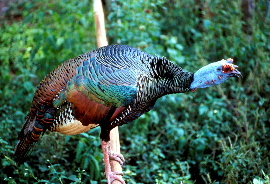|
| 질의: muscovy duck | 결과: 41번째/54 | |
Turkey (Family: Phasianidae, Genus: Meleagris) - Wiki
| 제목: | Turkey (Family: Phasianidae, Genus: Meleagris) - Wiki
| |

| 해상도: 270x184
파일크기: 51913 Bytes
촬영일: : : : :
사진기: Exif Viewer Ver.1.1 (FUJIFILM)
등록시간: 2007:11:22 13:17:07
|
Turkey (bird)
From Wikipedia, the free encyclopedia
Order: Galliformes
Family: Phasianidae
Subfamily: Meleagridinae
Genus: Meleagris
[Photo] Ocellated Turkey (Meleagris ocellata), public domain from USFWS
A turkey is either one of two species of large birds in the genus Meleagris native to North America. Turkeys are classed in the order Galliformes. Formerly they were considered a distinct family, Meleagrididae, but more recently were reclassified as a subfamily (Meleagridinae) of the pheasants and their allies. Turkeys have a distinctive fleshy carbuncle that hangs from the beak, called a snood. As with many galliform species, the female is smaller than the male, and much less colorful. With wingspans of 1.5???1.8 meters (almost 6 feet), the turkeys are by far the largest birds in the open forests in which they live, and are rarely mistaken for any other species. The usual lifespan for a turkey is 10 years. The fleshy protuberance attached to the underside of the beak is known as a "wattle".
Species of turkey
The two species are the North American Wild Turkey (M. gallopavo) and the Central American Ocellated Turkey (M. ocellata). The White Holland is a breed of turkey raised commercially for its meat.
Naming
When Europeans first encountered turkeys in the Americas, they incorrectly identified the birds as a type of guinea fowl (Numida meleagris), also known as a turkey-cock from its importation to Central Europe through Turkey, and the name of that country stuck as the name of the bird. The confusion is also reflected in the scientific name: meleagris is Greek for guinea-fowl.
The names for M. gallopavo in other languages also frequently reflect its exotic origins, seen from an Old World viewpoint, and add to the confusion about where turkeys actually came from. The many references to India seen in common names go back to a combination of two factors: first, the genuine belief that the newly-discovered Americas were in fact a part of Asia, and second, the tendency during that time to attribute exotic animals and foods to a place that symbolized far-off, exotic lands. The latter is reflected in terms like "Muscovy Duck" (which is from South America, not Muscovy). This was a major reason why the name "turkey-cock" stuck to Meleagris rather than to the guinea fowl (Numida meleagris): the Ottoman Empire represented the exotic East much the same as did India.
Several other birds which are sometimes called "turkeys" are not particularly closely related: the Australian brush-turkey is a megapode, and the bird sometimes known as the "Australian turkey" is in fact the Australian Bustard, a gruiform. The bird sometimes called a Water Turkey is actually an Anhinga (Anhinga rufa).
Fossil turkeys
Many turkeys have been described from fossils. The Meleagridinae are known from the Early Miocene (c. 23 mya) onwards, with the extinct genera Rhegminornis (Early Miocene of Bell, U.S.) and Proagriocharis (Kimball Late Miocene/Early Pliocene of Lime Creek, U.S.). The former is probably a basal turkey, the other a more contemporary bird not very similar to known turkeys; both were much smaller birds. A turkey fossil not assignable to genus but similar to Meleagris is known from the Late Miocene of Westmoreland County, Virginia (Olson, 1985).
In the modern genus Meleagris, a considerable number of species have been described, as turkey fossils are robust, fairly often found, and turkeys show much variation among individuals. Many of these supposed fossilized species are now considered junior synonyms. One, the well-documented California Turkey Meleagris californica, became extinct recently enough to have been hunted by early human settlers, though its actual demise is more probably attributable to climate change at the end of the last ice age. The modern species and the California Turkey seem to have diverged approximately one million years ago. Turkeys known only from fossils:
Meleagris sp. (Early Pliocene of Bone Valley, U.S.)
Meleagris sp. (Late Pliocene of Macasphalt Shell Pit, U.S.)
Meleagris californica (Late Pleistocene of SW U.S.) - formerly Parapavo/Pavo
Meleagris crassipes (Late Pleistocene of SW North America)
http://en.wikipedia.org/wiki/Turkey_%28bird%29
| The text in this page is based on the copyrighted Wikipedia article shown in above URL. It is used under the GNU Free Documentation License. You may redistribute it, verbatim or modified, providing that you comply with the terms of the GFDL. |
|
^o^
동물그림창고 똑똑전화 누리집
^o^
|
|

